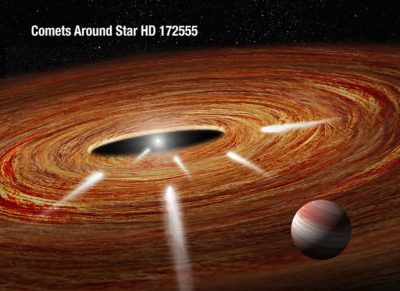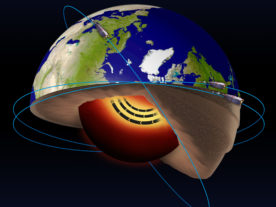Ants Balance Work and Rest to Maintain Colony
Ants have a reputation of being dedicated and hardworking creatures.
But did you know that like humans, ants also seek to maintain a healthy balance of work and rest?
While an ant colony appears to be filled with busy workers, according to new research, there are also a number of ants just lying around and not doing a thing.
Rather than belittling them for not carrying their share of the work load, these so called “lazy ants” are still providing a valuable service to their colony.
According to scientists at the Missouri University of Science and technology, it’s important for some of the ants to take it easy and not use up too much of the group’s food, energy, and resources, which colony needs to be productive.
The researchers also find found that the larger the colony, the more important this work-rest balance becomes.

Computer-generated image: Red oval marks disk of Milky Way galaxy – red dot shows the location of the Sagittarius dwarf galaxy. The yellow circles are stars that have been ripped from the Sagittarius dwarf and flung far across space. (Marion Dierickx/CfA)
Milky Way Looting Stars from Neighboring Galaxy
According to Harvard astronomers, it appears that our Milky Way is stealing stars from a nearby satellite galaxy.
Fresh research, based on computer models, suggests that five or six of the eleven farthest known stars in the Milky Way have been yanked from the Sagittarius dwarf galaxy.
These stars, located outside of the Milky Way’s spiral, are about 300,000 light years from Earth.
There are dozens of these mini satellite galaxies, like the Sagittarius dwarf, that surround the Milky Way.
Scientists say since the beginning of the universe they have circled our galaxy several times.
As they do, the Milky Way’s tidal gravity pulls on the smaller galaxies and pulls them apart like taffy.
This allows their stars to migrate toward our galaxy in streams that can reach as far as one million light-years from the Milky Way’s center.

Artist impression shows several comets speeding across a vast protoplanetary disc of gas and dust and heading straight for the youthful, central star HD 172555. (NASA, ESA, and A. Feild and G. Bacon (STScI))
Astronomers Spot Exocomets Falling into Star
You’re probably familiar with extra solar or exoplanets – planets found beyond our own solar system.
But now thanks to NASA’s Hubble Space Telescope scientists detected exocomets – comets that are located outside of the solar system plummeting into a young star called HD 172555.
The star is about 95 light-years from earth and is thought to be about 23 million years old.
These recent observations of exocomets mark the third time these objects have been spotted in star systems beyond our own.
The two previous occasions where they were detect also happened to be in solar systems that are less than 40 million years old.
While the exocomets have not been seen directly, they spotted after the Hubble detected gas scientists think is probably the vaporized remains of their icy nuclei.

Artist conception portrays a collection of planet-mass objects that have been flung out of the galactic center at speeds of 10,000 km/s. These cosmic “spitballs” formed from fragments of a star that was shredded by the galaxy’s supermassive black hole. (Mark A. Garlick/CfA)
Black Hole Flings Planet-Like Objects Throughout Galaxy
Astronomers say there is a supermassive black hole situated at the very center of our Milky Way galaxy.
Every now and then a star will get too close and the black hole’s tremendous gravity will rip the star to shreds.
While a much of the star gets pulled into the black hole, some of the star’s gas is hurled away at a rapid speed.
Scientists at the Harvard-Smithsonian Center for Astrophysics found that left over gas from one shredded star can form hundreds of planet-sized objects with a weight similar to Neptune and several Jupiter’s.
Because of the high speed the gas is already traveling these objects are blasted throughout the galaxy like giant “spitballs.”
Calculations from the scientists indicate that the closest of these planet-like objects might be within a few hundred light-years of Earth.
The researchers point out that other galaxies, such as Andromeda are also shooting these objects out at us all the time.
Is Our Moon Just One in a Series of Past Moons?
The most popular theory on how the moon was formed is called the giant impact hypothesis.
According to this proposition, our moon was made from the debris left over from a violent collision, about 4.5 billion years ago, between Earth and a Mars-sized protoplanet.
Now a group of Israeli scientists have developed a new theory that suggests the moon we now see in the night sky is not Earth’s first and only moon, but that there were actually a number of moons that preceded it throughout our planet’s history.
The group’s findings, based on a model, suggests that each of the series of moons that circled ancient Earth were formed from different collisions with the still forming planet.
One of the study’s co-authors says that it was likely that these moonlets were either ejected into space, that they crashed into Earth or with each other to form bigger moons.
 Human Biology Not Lack of Willpower Causes Diets to Fail
Human Biology Not Lack of Willpower Causes Diets to Fail
One of the most popular resolutions people make with the New Year is to lose weight.
Whether it’s missing favorite foods or being frustrated with not losing enough weight as quickly as thought, many people unfortunately tend to give up within a week or so starting their weight loss program.
Dr. David Ludwig from the Harvard Medical School suggests biology and not a lack of willpower may be more responsible for these efforts at weight loss to fail.
He advises against eating hyperprocessed fast foods and go with whole and natural foods, which are more likely to be efficiently used by the body and brain and doesn’t turn into fat as easily.
Dr. Ludwig suggests a diet with foods such as whole fruits, vegetables, a good amount of protein, which doesn’t necessarily have to be meat, and surprisingly plenty of high-fat foods.
This could include various nuts, nut butters, foods prepared with olive oil, and even full-fat dairy products.



 Human Biology Not Lack of Willpower Causes Diets to Fail
Human Biology Not Lack of Willpower Causes Diets to Fail




















In the local group the Milky Way has about 16 satellite galaxies, Andromeda 25, and Triangulum perhaps 1. Large galaxies absorb their satellites over time. While the Milky Way is about 100,000 light years in diameter, its influence reaches out to about a million light years nearly halfway to Andromeda 2.6 million light years away. In about 5 billion years Andromeda and the Milky Way will collide eventually forming one large elliptical galaxy. This process has been observed all over the universe. It is part of the natural order of things.